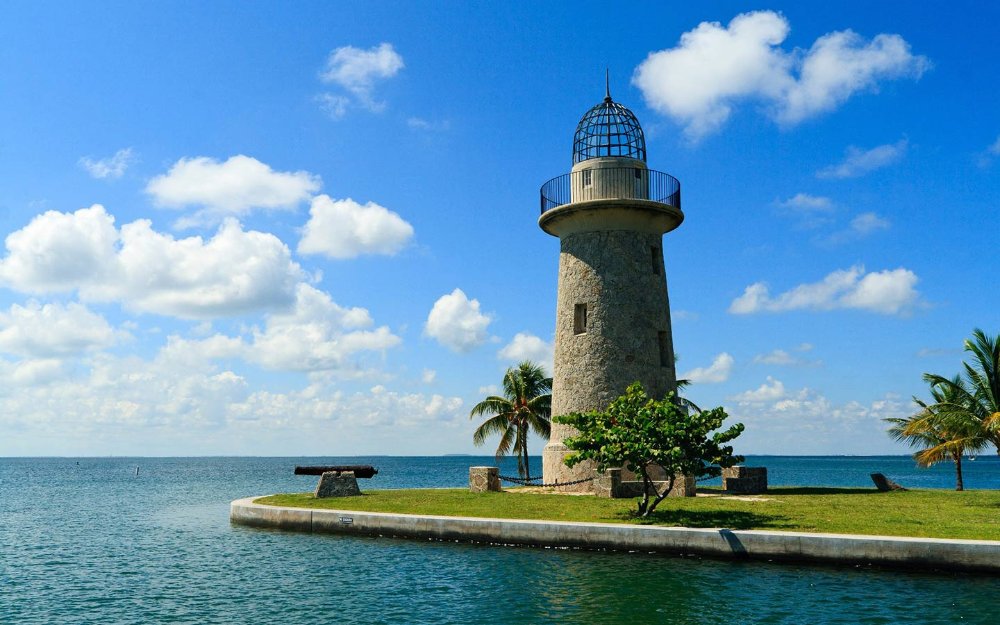Biscayne National Park is a stunning natural wonder located in southern Florida. The park is situated within sight of Miami, yet it feels worlds away from the hustle and bustle of the city. Biscayne National Park is home to a rare combination of aquamarine waters, emerald islands, and fish-bejeweled coral reefs.
Get Off the Beaten Path with Our National Parks Guide
The park is spread over 172,000 acres and includes Biscayne Bay, mangrove forests, offshore barrier reefs, and the northernmost section of the Florida Keys. It is a haven for snorkeling, boating, and diving, with the third longest coral reef system in the world. Visitors can explore the park’s diverse marine life, including over 500 species of fish, manatees, sea turtles, and dolphins.
Biscayne National Park also offers a glimpse into the area’s rich history, with evidence of 10,000 years of human history, from prehistoric tribes to shipwrecks, and pineapple farmers to presidents. Visitors can explore the park’s historic sites, including the 1930s Boca Chita Lighthouse, which offers one of the best views of the park. Whether you’re a nature lover, history buff, or just looking for a peaceful escape, Biscayne National Park is a must-visit destination in Florida.
Location and History
Geography
Biscayne National Park is a national park located in southern Florida, USA. The park is situated in Miami-Dade County, just a few miles south of Downtown Miami. It encompasses Biscayne Bay and its offshore barrier reefs, with 95% of the park being water. The park covers an area of 172,924 acres (70,004 hectares), including the northernmost Florida Keys.
The park includes several islands, including Elliott Key, Boca Chita Key, and Adams Key. It also features several bodies of water, including Jones Lagoon and Stiltsville, which are popular spots for boating and fishing.
History
Biscayne National Park has a rich history dating back over 10,000 years. Evidence of prehistoric tribes and shipwrecks can be found in the park. The park was established as Biscayne National Monument in 1968, and in 1980, it became a national park.
One of the most notable events in the park’s history was Hurricane Andrew in 1992, which caused extensive damage to the park’s infrastructure. The park was closed for several months while repairs were made.
Today, the park is a popular destination for visitors from all over the world. In addition to its natural beauty, the park is home to the Maritime Heritage Trail, which includes several shipwrecks and other historic sites. Visitors can also enjoy a variety of recreational activities, such as boating, fishing, and snorkeling.
Overall, Biscayne National Park is a unique and beautiful destination that offers visitors a glimpse into the rich history and natural beauty of South Florida.
Wildlife and Ecosystems
Biscayne National Park is home to a diverse range of flora and fauna, including four distinct ecosystems that merge into each other, creating rich edge communities or “ecotones” [1]. These ecosystems support an incredible array of wildlife, including manatees, sea turtles, hundreds of species of birds and fish, and plants and insects found nowhere else in the United States [2].
Flora
The park’s flora is dominated by mangroves, which cover almost 95% of the park’s shoreline [1]. These trees are adapted to grow in salty water and are an essential part of the park’s ecosystem, providing habitat for a wide range of marine life, including fish, crabs, and shrimp. Other plant species found in the park include seagrasses, which are the foundation of the park’s food chain, and a variety of shrubs and trees that grow in the upland areas of the park [2].
Fauna
Biscayne National Park is home to an incredible variety of marine life, including over 500 species of fish and 75 species of coral [1]. The park’s coral reefs are home to a diverse range of marine life, including sharks, turtles, and a variety of colorful fish. The park is also home to a large population of manatees, which are a threatened species, and bottlenose dolphins, which are a common sight in the park’s aquamarine waters [3].
Ecosystems
Biscayne National Park protects four distinct ecosystems, each of which is interconnected and consists of both living and non-living components. These ecosystems include the longest stretch of mangrove forest on Florida’s east coast, the southern expanse of Biscayne Bay, the northernmost part of the Florida Keys, and a portion of the world’s third-longest coral reef, the Florida Reef [2]. The park’s coral reefs are home to a wide variety of coral species, including staghorn and elkhorn coral, which are both listed as threatened under the Endangered Species Act [1].
In addition to the park’s coral reefs, the park’s mangrove forests are also important ecosystems, providing habitat for a wide range of marine life, including fish, crabs, and shrimp. The park’s seagrass beds are also essential ecosystems, providing food and habitat for a variety of marine life, including manatees, sea turtles, and native fish species [2].
Biscayne National Park is also home to a variety of bird species, including the roseate spoonbill, which is a threatened species, and a variety of other wading birds. The park’s islands are also important habitats for a variety of wildlife, including nesting sea turtles and a variety of bird species [3].
Overall, Biscayne National Park is an important ecosystem that provides habitat for a wide range of marine life and is home to a diverse range of flora and fauna. The park’s coral reefs, mangrove forests, seagrass beds, and islands are all essential ecosystems that support a wide range of wildlife and are important for the health of the park’s ecosystem.
References:
- Ecosystems – Biscayne National Park (U.S. National Park Service)
- Wildlife in Biscayne National Park | Greater Miami & Miami Beach
- How to visit Biscayne National Park – National Geographic
Activities and Attractions
Biscayne National Park offers a wide range of activities and attractions that cater to visitors of all ages and interests. Here are some of the top things to do in the park:
Diving and Snorkeling
Biscayne National Park is home to some of the most spectacular coral reefs in the world, making it a popular destination for diving and snorkeling enthusiasts. Visitors can explore colorful coral formations, swim alongside schools of tropical fish, and discover hidden shipwrecks. The Maritime Heritage Trail is a must-visit for history buffs, with six shipwrecks that have been preserved and marked for exploration.
Boating and Sailing
With over 95% of the park covered by water, boating and sailing are among the most popular activities in Biscayne National Park. Visitors can rent a boat or join a guided tour to explore the park’s stunning coastline, islands, and waterways. The park’s marinas, including Homestead Bayfront and Black Point, offer easy access to the park’s waters.
Fishing
Fishing is another popular activity in Biscayne National Park. Visitors can cast a line from the shore, a pier, or a boat and try their luck at catching a variety of fish species, including snapper, grouper, and tarpon. The park has strict regulations to protect its marine life, so it’s important to check the rules before fishing.
Kayaking and Paddling
Exploring Biscayne National Park by kayak or paddleboard is a unique and peaceful way to experience the park’s natural beauty. Visitors can paddle through mangrove forests, along the park’s shoreline, or to one of the park’s islands, such as Adams Key or Boca Chita Key. The park offers rentals, tours, and guided trips for visitors who want to explore the waterways.
Hiking and Wildlife Watching
While much of Biscayne National Park is covered by water, there are still plenty of opportunities for hiking and wildlife watching. The park has several trails, including the Jetty Trail and the Biscayne Birding Trail, that offer visitors the chance to explore the park’s diverse ecosystems and spot a variety of wildlife, including birds, manatees, and crocodiles.
Camping and Picnicking
For visitors who want to spend more time in the park, camping and picnicking are great options. The park has several campsites, including the Boca Chita Lighthouse and Elliot Key, that offer visitors a chance to spend the night under the stars. Visitors can also pack a picnic and enjoy a meal at one of the park’s many picnic areas, such as Convoy Point.
Overall, Biscayne National Park offers visitors a chance to experience a unique and diverse ecosystem that is home to a variety of marine and terrestrial wildlife. Whether you’re interested in exploring the park’s coral reefs, paddling through mangrove forests, or camping under the stars, Biscayne National Park has something for everyone.
Regulations and Permitting
Permitting
Biscayne National Park requires permits for certain activities to preserve the natural resources and ensure visitor safety. The permits are issued by the park and must be obtained in advance. Here are some examples of activities that require permits:
- Fishing: If you plan to fish in the park, you need a Florida fishing license and a park fishing permit. The park has specific regulations on fishing, such as size limits and bag limits. Check the park’s website for more information on fishing regulations and how to obtain a permit.
- Boating: If you plan to bring your own boat into the park, you need a boating permit. The park has specific regulations on boating, such as speed limits and no-wake zones. Check the park’s website for more information on boating regulations and how to obtain a permit.
- Commercial activities: If you plan to conduct any commercial activities in the park, such as filming or conducting research, you need a special use permit. Check the park’s website for more information on special use permits and how to obtain one.
Regulations
Biscayne National Park has regulations that visitors must follow to protect the park’s natural resources and ensure visitor safety. Here are some of the park’s regulations:
- Coral reef protection areas: The park has designated coral reef protection areas where certain activities are prohibited or restricted, such as fishing or anchoring. Check the park’s website for more information on the coral reef protection areas and the regulations that apply.
- Aggregate bag limit: The park has an aggregate bag limit for certain fish species, which means that you can only keep a certain number of fish per person per day. Check the park’s website for more information on the aggregate bag limit and the fish species that apply.
- Building permits: If you plan to build or remodel a structure in Biscayne Park, you need a building permit. Check the park’s website for more information on building permits and how to obtain one.
It’s important to follow the park’s regulations and obtain the necessary permits to ensure that you have a safe and enjoyable visit while also protecting the park’s natural resources for future generations to enjoy.
Biscayne National Park Institute
Biscayne National Park Institute is a unique partnership between Biscayne National Park and its official nonprofit partner, Florida National Parks Association. The Institute provides immersive, educational experiences for visitors of Biscayne National Park. The Institute offers a variety of eco-adventures, including snorkeling at a shipwreck on the Maritime Heritage Trail and colorful coral reefs full of life, cruises to Boca Chita Key and lighthouse, sailing on beautiful Biscayne Bay, exploring the seldom seen wonders of Jones Lagoon, and more!
The Institute also provides educational opportunities for visitors to learn about the park’s unique ecosystem and the challenges it faces. Visitors can learn about the various plant species and wildlife that live in the mangroves and seagrass meadows through a guided paddling kayak tour. The Institute also offers a variety of ranger-led programs, including guided hikes, bird watching, and stargazing events.
The Biscayne National Park Institute is committed to promoting environmental stewardship and conservation through education and outreach. The Institute offers a variety of educational programs for schools and community groups, including field trips, classroom visits, and teacher workshops. The Institute also partners with local organizations to promote environmental awareness and conservation in the community.
Overall, the Biscayne National Park Institute is a valuable resource for visitors to Biscayne National Park. Whether you’re looking to explore the park’s unique ecosystem, learn about its history and culture, or get involved in environmental conservation efforts, the Institute has something to offer.
Visitor Information
If you’re planning a trip to Biscayne National Park, there are a few things you should know to make your visit as enjoyable as possible. Here’s everything you need to know about getting there, visitor centers, resources, and plans.
Getting There
Biscayne National Park is located in southern Florida, within sight of the Miami skyline. The park is accessible by car, boat, and public transportation. If you’re driving, take the Florida Turnpike to Exit 6 (Speedway Boulevard) and follow the signs to the park. If you’re taking public transportation, you can take the Miami-Dade bus to Homestead Bayfront or the Miami-Dade Metrorail to the Dadeland South Station and then transfer to the bus.
Visitor Centers
The Dante Fascell Visitor Center is the main visitor center for Biscayne National Park. It is located at Convoy Point and is open daily from 9 a.m. to 5 p.m. except for holidays. Here, you can learn about the park’s history, wildlife, and conservation efforts. You can also pick up maps, brochures, and other resources to help you plan your visit.
Resources
Biscayne National Park is a unique destination that offers a wide range of activities for visitors of all ages. During the winter months, the park is a popular spot for snorkeling, fishing, and boating. If you’re interested in exploring the park’s natural beauty, be sure to take a hike on Elliott Key, the largest island in the park. You can also take a guided tour of the park or rent a kayak or canoe to explore the park’s waterways.
Plans
Before you visit Biscayne National Park, it’s a good idea to make a plan. Decide what activities you want to do and how much time you want to spend in the park. Be sure to check the park’s website for updated information on park hours, fees, and closures. You can also download maps and brochures to help you plan your visit. Remember to respect the park’s wildlife and natural resources and follow Leave No Trace principles to help preserve the park for future generations.
Frequently Asked Questions
What are some interesting facts about Biscayne National Park?
Biscayne National Park is a unique combination of aquamarine waters, emerald islands, and fish-bejeweled coral reefs. It is located within sight of Miami, yet worlds away. The park protects a rare combination of natural and cultural resources, including evidence of 10,000 years of human history, from prehistoric tribes to shipwrecks, and pineapple farmers to presidents.
How large is Biscayne National Park?
Biscayne National Park is 172,971 acres, with 95% of the park being underwater. The park includes a variety of ecosystems, including mangrove forests, coral reefs, and seagrass beds.
Can you go snorkeling in Biscayne National Park?
Yes, snorkeling is a popular activity in Biscayne National Park. The park offers a variety of snorkeling opportunities, including guided tours and self-guided snorkeling trails. Visitors can explore the park’s coral reefs and see a variety of marine life, including colorful fish, sea turtles, and even sharks.
What is the admission fee for Biscayne National Park?
The admission fee for Biscayne National Park is $30 per vehicle for a seven-day pass. The fee for individuals entering the park on foot or by bicycle is $15 per person for a seven-day pass. Annual passes are also available for $55.
What kind of animals can you see in Biscayne National Park?
Biscayne National Park is home to a variety of wildlife, both on land and in the water. Visitors may see manatees, dolphins, sea turtles, and a variety of fish and other marine life. On land, visitors may see a variety of bird species, including pelicans, herons, and ospreys.
Are there any unique landforms in Biscayne National Park?
While the majority of Biscayne National Park is underwater, there are a few unique landforms to explore. Visitors can explore Elliott Key, the largest island in the park, or Boca Chita Key, which features a historic lighthouse and scenic views of the park. The park also includes a variety of mangrove forests and seagrass beds to explore.

Meet Kevin Goodell, your outdoor adventure coach! With a passion for nature ignited in childhood, Kevin brings a wealth of experience and expertise to simplify tough outdoor skills. As a U.S. Army veteran and former Sergeant, he has honed his leadership and teamwork abilities while developing a deep love for the great outdoors.
Kevin’s dedication to outdoor activities spans biking, birdwatching, national park trips, and archery/golf. With his friendly and approachable demeanor, he is committed to guiding individuals of all ages and skill levels towards unforgettable outdoor experiences.
Harnessing his extensive knowledge and personal achievements, Kevin is your go-to resource for learning and enjoying various outdoor pursuits. Whether you seek thrilling adventures or serene nature escapes, Kevin’s professional yet friendly approach will ensure an engaging and informative experience. Embark on your next outdoor adventure with Kevin Goodell and embrace the beauty of nature like never before.






